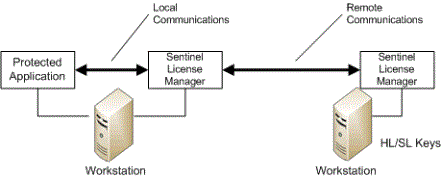Remote Communications

This section describes communication between the local Sentinel License Manager service and a remote Sentinel License Manager service.
This type of communication occurs when the protected application is running on a different computer from the computer where the Sentinel protection key is installed.
The protected application communicates only with the local Sentinel License Manager on the computer where the application is running, as described in Local Communications. The local Sentinel License Manager discovers and communicates with the License Manager on the computer containing the Sentinel protection key using one of the following methods:
> If the option Broadcast Search for Remote Licenses is selected in the Admin Control Center (in the Access From Remote Clients tab of the Configuration page), the local Sentinel License Manager issues a UDP broadcast to local subnets on port 1947 using:
•IPv4 (always)
•IPv6 (if available)
The option Broadcast Search for Remote Licenses is selected by default.
>For addresses specified in the Admin Control Center field Remote License Search Parameters or Specify Search Parameters (in the Access From Remote Clients tab of the Configuration page), the local License Manager does the following:
•For a local Admin License Manager: The License Manager issues a UDP “ping” packet to port 1947 for all addresses specified. These addresses may be individual machine addresses or broadcast addresses.
•For a local Integrated License Manager or External License Manager: The License Manager sends a TCP request to all individual addresses. If the field contains a broadcast address (xxx.xxx.xxx.255), the License Manager send a UDP broadcast to discover a running server at that broadcast address.
All Sentinel License Managers found by the discovery process are then connected via TCP port 1947, using IPv4 or IPv6 as detected during discovery, and data regarding the remote Sentinel protection keys are transferred.
This discovery process is repeated at certain intervals. (The interval size depending on a number of factors, but it is generally not less than five minutes.)
UDP packets sent and received in the discovery process contain the Sentinel License Manager GUID (40 bytes of payload data).
When starting or stopping a Sentinel License Manager, and when adding or removing a Sentinel protection key, a UDP notification packet is sent, containing the Sentinel License Manager GUID and a description of the changes encountered. This is done to allow other Sentinel License Managers to update their data before the next scheduled discovery process.
TCP packets between two Sentinel License Managers on different computers use HTTP with base-64 encoded data in the body section.
